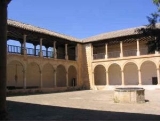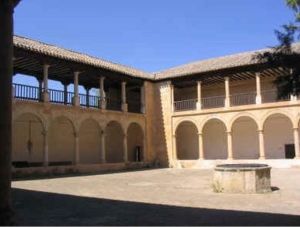
Fuensanta, Albacete
Encyclopedia
Fuensanta is a municipality
located to the north of the province of Albacete. This province belongs to the Independent Community of Castilla-La Mancha (Spain
). The locality is in the Federeation of La Mancha del Júcar-Centro. The municipality has 366 inhabitants, is 36 km. from the provincial capital, and occupies an area of 23,96 km².
 After a supposed Consecrated virgin
After a supposed Consecrated virgin
's appearance in 1482 that gave rise to the birth of a spring, a small hermitage was based here that belonged to the population of La Roda
. Towards 1561 the Trinitaria Order was able to buy the hermitage to build a monastery, after a long conflict with the parish of La Roda.
With time the people of the environs began to go to receive baths in the holy spring, and the maiden went away, creating a small village that would give rise to the birth of the municipality. In 1579 it had 20 people.
In 1671 the population already had 40 people, due to the segregation of La Roda and its constitution in an independent town after the payment of 337,500 maravedíes to the king. The Stem initiated a lawsuit against this decision that ended the confirmation of the segregation of the Fuen Santa in 1672.
With the confiscation of the goods of the Church at the beginning of the 19th century, the Monastery of the Trinitarios was abandoned, with time becoming the property of the City council, while its temple will become the local parish, replacing the old one.
The temple is formed by a rectangular square covered with vaults
. The top supports a dome which is adorned with medallions of Trinitarios saints in plaster relief. The entry room of the temple is covered by a dome with pictorial decorations. The outside is of simple construction, of baroque style.
The cloister of the temple was constructed in the 16th century, and is composed of an ample space squared with double porticada galleries; arches with columns that maintain the thresholds of corridors.
In the old orchards of the convent, a small chapel is conserved with great devotion from the population since it was in the spring where the appearance of the Virgin occurred.
Another religious building of the town of Fuensanta is the old parish of San Gregorio Nacianceno, constructed in the 17th century that at the moment is a particular property turned into warehouse.
Barroca of the 18th century style exists in the town in one old compound divided into three distinct houses, in which it emphasizes its Rococo facade and good rejería. Also a small palace exists of modernist style known as Villa Manolita or the House the Mannas that was reconstructed in 2003 to turn it into a rural shelter.
Municipality
A municipality is essentially an urban administrative division having corporate status and usually powers of self-government. It can also be used to mean the governing body of a municipality. A municipality is a general-purpose administrative subdivision, as opposed to a special-purpose district...
located to the north of the province of Albacete. This province belongs to the Independent Community of Castilla-La Mancha (Spain
Spain
Spain , officially the Kingdom of Spain languages]] under the European Charter for Regional or Minority Languages. In each of these, Spain's official name is as follows:;;;;;;), is a country and member state of the European Union located in southwestern Europe on the Iberian Peninsula...
). The locality is in the Federeation of La Mancha del Júcar-Centro. The municipality has 366 inhabitants, is 36 km. from the provincial capital, and occupies an area of 23,96 km².
History

Consecrated virgin
In the Catholic Church a consecrated virgin is a woman who has been conscrated by the church to a life of perpetual virginity in the service of God. Consecrated virgins are to spend their time in works of penance and mercy, in apostolic activity and in prayer, according to their state of life and...
's appearance in 1482 that gave rise to the birth of a spring, a small hermitage was based here that belonged to the population of La Roda
La Roda
La Roda is a village located in the autonomous community of Castile-La Mancha, Province of Albacete, Spain.-Description:The village has a population of around 15000 people. It is an important industrial town. Its most famous building is the church which dates from the 15th century.Its main culinary...
. Towards 1561 the Trinitaria Order was able to buy the hermitage to build a monastery, after a long conflict with the parish of La Roda.
With time the people of the environs began to go to receive baths in the holy spring, and the maiden went away, creating a small village that would give rise to the birth of the municipality. In 1579 it had 20 people.
In 1671 the population already had 40 people, due to the segregation of La Roda and its constitution in an independent town after the payment of 337,500 maravedíes to the king. The Stem initiated a lawsuit against this decision that ended the confirmation of the segregation of the Fuen Santa in 1672.
With the confiscation of the goods of the Church at the beginning of the 19th century, the Monastery of the Trinitarios was abandoned, with time becoming the property of the City council, while its temple will become the local parish, replacing the old one.
Monuments
In the locality of Fuensanta is a parish, the old convent of Trinitarios friars, in whom it venerates Our Lady of the Remedies of Fuensanta. At the moment the temple is formed by two parts, the temple and the cloister.The temple is formed by a rectangular square covered with vaults
Vault (architecture)
A Vault is an architectural term for an arched form used to provide a space with a ceiling or roof. The parts of a vault exert lateral thrust that require a counter resistance. When vaults are built underground, the ground gives all the resistance required...
. The top supports a dome which is adorned with medallions of Trinitarios saints in plaster relief. The entry room of the temple is covered by a dome with pictorial decorations. The outside is of simple construction, of baroque style.
The cloister of the temple was constructed in the 16th century, and is composed of an ample space squared with double porticada galleries; arches with columns that maintain the thresholds of corridors.
In the old orchards of the convent, a small chapel is conserved with great devotion from the population since it was in the spring where the appearance of the Virgin occurred.
Another religious building of the town of Fuensanta is the old parish of San Gregorio Nacianceno, constructed in the 17th century that at the moment is a particular property turned into warehouse.
Barroca of the 18th century style exists in the town in one old compound divided into three distinct houses, in which it emphasizes its Rococo facade and good rejería. Also a small palace exists of modernist style known as Villa Manolita or the House the Mannas that was reconstructed in 2003 to turn it into a rural shelter.
Celebrations
- May 9: Day of Saint Gregory of NazianzusGregory of NazianzusGregory of Nazianzus was a 4th-century Archbishop of Constantinople. He is widely considered the most accomplished rhetorical stylist of the patristic age...
. - The Saturday following San Gregorio: celebration of the Return of the Virgin of the Remedies to La RodaLa RodaLa Roda is a village located in the autonomous community of Castile-La Mancha, Province of Albacete, Spain.-Description:The village has a population of around 15000 people. It is an important industrial town. Its most famous building is the church which dates from the 15th century.Its main culinary...
. - Three weeks later: celebration of the return of the Virgin to Fuensanta.
- Culture week from August 9 through the 15th.
- September 8: Fair of the Virgin of the Remedies.

